 This article contains James Sinnamon's submission to the Parliamentary Joint Committee on Intelligence and Security (PJCIS) which wants to pass new laws to make all your emails and other internet transactions up to two years back accessible to the Australian Government. "If Australian governments were serious about protecting Australians from terrorism, they would not have given transnational corporations with interests in every kind of industry including military total access to information about resources and infrastructure relating to location and operation of power, water supply and telecommunications, land-use planning, national statistics, scientific research institutions and banks. What is left, I ask, for terrorists?" (James Sinnamon)
This article contains James Sinnamon's submission to the Parliamentary Joint Committee on Intelligence and Security (PJCIS) which wants to pass new laws to make all your emails and other internet transactions up to two years back accessible to the Australian Government. "If Australian governments were serious about protecting Australians from terrorism, they would not have given transnational corporations with interests in every kind of industry including military total access to information about resources and infrastructure relating to location and operation of power, water supply and telecommunications, land-use planning, national statistics, scientific research institutions and banks. What is left, I ask, for terrorists?" (James Sinnamon)

Also published on Global Research.
Australian Government wants to read your private business and personal correspondence
The Australian Parliamentary Joint Committee on Intelligence and Security (PJCIS) paper claims that Australia faces terrorist threats and that, in order to defeat these threats:
1. It is to be made an offence for any citizen to fail to "assist in the decryption of communications". In other words, each Internet user may not refuse to give to government agencies a copy of his/her private encryption key so that all his/her electronic business and private correspondence can be read by police and security agencies.
2. It be required that data transmitted by all Internet users be retained for up to two years by their respective Internet Service Providers (ISPs).
So, if these proposals become law, Internet users will be required to allow police and security agencies to read all business and personal correspondence and data uploads, as well as any more going back up to two years.
Nowhere, in the discussion paper, has it been shown how these sweeping powers could have prevented past acts of terrorism or other criminal acts from being carried out on Australian soil.
In Chapter two, Interception and the TIA Act, the paper notes the greater power and sophistication of communication technologies made available to terrorist and criminal organisations since 1979 when the current Act was enacted.
However, no-where in the paper is the commensurate increase in sophistication and power of surveillance technologies available to police and security agencies acknowledged or factored in.
If the paper acknowledged that the government possesses equal and possibly superior surveillance technologies to non-government agencies, I believe that the basis of these proposed changes to the law would be nullified.
One-sided appraisal of technology fails to admit Government already technologically well-empowered
From their present one-sided appraisal of technology, the Committee has made a breathtaking leap of logic by claiming that only by, in effect, treating all Australian Internet Users as potential terrorists or potential criminals and by subjecting them to the surveillance that only criminal and terrorist suspects were previously subjected to, could the law enforcement authorities and security agencies provide us with the protection that they were previously able to.
The report shows how current targeted surveillance powers have been effective in thwarting numerous crimes:
"In 2010/2011 there were 2441 arrests, 3168 prosecutions (2848 for serious offences) and 2034 convictions (1854 for serious offences) based on lawfully intercepted material. 2 Law enforcement agencies made 91 arrests, 33 prosecutions and obtained 33 convictions based on evidence obtained under stored communications warrants.
"These figures may underestimate the effectiveness of interception because a conviction can be recorded without entering the intercepted material into evidence. Interception also allows agencies to identify criminal connections, ...
"Telecommunications data is commonly the first source of important lead information for further investigations and often provides a unique and comprehensive insight into the behaviour of persons of interest." (p14)
The discussion paper fails to explain why, if this was possible under existing laws, the proposed additional powers are necessary.
Four cases in which suspects have been convicted of conspiring to commit terrorist acts are also cited, but, again, the paper fails to explain why, if this was possible under existing laws, the proposed additional powers are necessary.
Australian participation in illegal wars
How can Australia expect other nations to respect our own sovereignty and territorial integrity, when it has failed to accord that respect to other nations?
Since 1991, Australia has participated in three illegal wars under false pretexts: Two against Iraq and, our longest ever war, in which we are still engaged, against Afghanistan. As a result of the wars against Iraq and sanctions in which Australia participated, some estimates put the death toll as high as one million.
The 1991 war against Iraq was launched after Iraq had been cynically tricked into invading Kwait by the then ambassasor to Kuawit April Glaspie, who has since disappeared from public view. In order to overcome opposition to that war, the "Incubator babies" story, in which cruel Iraqi invaders were said to have thrown babies out of incubators onto hospital floors was fabricated. In 2003 it was claimed that Iraq posed a threat to the world with its renewed Weapons of Mass Destruction program. This claim was demolished in 2003 before the US Congress of CIA by CIA agent Valerie Plame, who testified that she had found no evidence of Iraq WMDs.
False flag terrorism
No-where in this discussion paper is another source of terrorism acknowledged, that is false flag terrorism. False flag terrorism is carried out by governments seeking to justify repression and gain political advantage by blaming the terrorism on opponents. Earlier this year, although it denies this, the Syrian Government was accused of having committed the Houla Massacre, in which 108 men, women and children were murdered in order to blame their deaths on the opposition Syrian National Council.
It was because the Syrian government was blamed for the Houla Massacre that the Australian Government expelled the Syrian Ambassador from Australia and imposed sanctions against Syria.
In October 2005 the late former President of Indonesia, Abdurrahman Wahid said, in an interview with SBS, that he believed that either the Indonesian military or the Indonesian police planted the second larger bomb which destroyed the Sari Club on 12 October 2002.[1] 202 people including 88 Australians perished in those attacks known as the Bali Bombing attacks.
Many credible figures including Lieutenant Colonel Robert Bowman, the former Director of Advanced Space Programs Development for the U.S. Air Force in the Ford and Carter administrations, believe that senior figures in the Bush administration were complicit in the terrorist attacks of September 11, 2001 in which almost 3,000 residents of the United States died. I stated my agreement with Lieutenant Colonel Bowman in my submission of 7 September 2009 to the Australian parliamentary Inquiry Into Human Rights on 7 September 2009.[2] I include a copy with this submission. [See copy as Endnote 7.] Until earlier this year that submission was posted on the Federal Parliamentary web-site along with all the other submissions.
In 1963, the US joint Chiefs of Staff put to President John F Kennedy that the US military stage apparent hijackings of civilian aircraft, terrorist murders and apparent military attacks against United States military bases in order to put the blame on Cuba. this proposal was known as Operation Northwoods.[3] Fortunately, President Kennedy rejected that proposal before he was sadly murdered.
Privatisation of Institutions and information
Successive Australian governments, both state and federal, have deregulated and privatised institutions and their information and outsourced services from the time of Keating. They have done this without the permission of the electorate, which has never been asked, as Financial Review Editor, Laura Tingle, recently put forward in her Quarterly Review essay, "Great Expectations,".[4] Corroborating Tingle's observations, sociologist, Sheila Newman wrote that,
"With deregulation and privatisation (under Hawke and Keating), governments dissolved the very institutions that gave them power. Because of Hawke and Keating’s actions, Australian governments now have so little power that they are unable to satisfy the promises they make at election time to the electorate."
How can Australian citizens trust governments which are now almost powerless against corporate interests to represent their citizens? How can the Committee ask Australians to cede yet more power and information to feeble government powers that have shown undeniable trends to privilege corporations like News Ltd with lax media ownership laws even when British parliamentary inquiries have exposed their management as condoning and encouraging spying at every level? How can the Committee ask Australians to cede yet more power and information to governments which have allowed a myriad of private fly-by-night organisations to take over our entire telecommunications system, power, water and other utilities, resulting in so many complaints that states have now replaced one omsbudsman with many omsbudsmen?
If Australian governments were serious about protecting Australians from terrorism, they would not have given transnational corporations with interests in every kind of industry including military total access to information about resources and infrastructure relating to location and operation of power, water supply and telecommunications, land-use planning, national statistics, scientific research institutions and banks.
What is left, I ask, for terrorists?
Surely Australia's best defense against terrorism lies in Australian citizens being able to protect their own interests and privacy from government and commercial organisations? Who else can they really trust?
Conclusion
To the extent that Australia faces a terrorist threat at all, the paper offers no practical proposal of how to meet that threat. In all likelihood, greater surveillance at the hands of Governments and security agencies, which have done so little to earn the trust of Australians, will only serve to make larger numbers more apathetic and less able to act if they see evidence of real terrorist threats.
Australians need more civil rights, not fewer, to ensure that dark or incompetent processes cannot proceed behind a wall of secrecy and ill-informed authority in the name of security. It has been suggested that Australia could consider adopting the European Civil Code, also known as the Napoleonic Code, instead of its 'ad hoc British system'. In the EU, only Britain has failed to adopt this Roman Law based model. Australia needs a Civil Code of citizens’ rights, legally defendable, modelled on the French one to combat the disorganising forces of the markets and perceived threats to security.[5]
There is a great deal more in the 61 pages of this discussion paper than I have been able to properly address in the limited time available to me. Nevertheless, I believe this submission demonstrates that the measures proposed in discussion paper pose an unwarranted threat to the democratic freedoms of Internet users.
The proposals have never been put to the voting public and had this been done I believe that they would have been rejected just as the Australian public previously rejected a proposal to filter Internet traffic.
Accordingly, I ask that either the proposals contained in the discussion paper be rejected by Parliament or that they be put to the public in a referendum.
ENDNOTES
[1] "Miscarriage of Justice: Who was behind the October 2002 Bali bombings?" by Michel Chossudovsky at http://www.globalresearch.ca/index.php?context=va&aid=10931
[2] The submission I made to the Australian parliamentary Inquiry Into Human Rights on 7 September 2009 contained the following factual errors:
(i) Lieutenant Colene Robert Bowman did not serve on "President Ronald Reagan's Star Wars program." He had retired when Jimmy Carter was President.
(ii) Morgan Reynolds, who is listed in my submission, claims that the WTC Twin Towers were destroyed by particle beams from outer space and that the aircraft seen to fly into each of the respective WTC Twin Towers were, in fact, holograms, so cannot be considered a credible supporter of 9/11 Truth.
[3] http://en.wikipedia.org/wiki/Operation_Northwoods
[4] Laura Tingle in "Great Expectations," Quarterly Essay, June 2012, p.34, writes: "Yet, here is the crucial point: voters weren't consulted about the changes - except belatedly at the ballot box, when both major parties were in fundamental accord."
[5] http://www.independentaustralia.net/2012/politics/tingle-verbals-australians-in-quarterly-essay
[6] Loose paraphrase from last paragraph in Sheila Newman, "Tingle-ing Australians," in Independent Australia
National Human Rights Consultation Submission
AGWW-7T293B
Name: James SINNAMON
The following is a verbatim adaptation of the three page submission I presented to the Australian Federal Parliamentary Inquiry Into Human Rights on 7 September 2011. On this adaptation I have corrected one relatively minor factual error and noted one misjudgement which appeared on the first. These are detailed in the Appendix at the end of this document. (This adaptation is four pages in length rather than three pages. This is because of difficulty I faced in copying and editing with the Open Source Libre Office Writer program the original PDF document.)
Submission Text:
This submission disputes the entire justification for the draconian anti-terrorist laws that have taken away from ordinary citizens, basic human rights and civil liberties that were once taken for granted in Australia.
As few cannot be unaware the justification for these draconian laws and the associated imposts upon our daily lives such as airport security checks and the banning of the ownership of megaphones, deemed by former Prime minister John Howard to be a terrorist weapon was the spectacular and deadly terrorist attack of 11 September 2001, the anthrax scare that shortly ensued and a number of other deadly terrorist attacks that have occurred since then - Bali, the Madrid bombing and the London Tube bombing. Much of Australian public opinion had come to accept that the curtailments of our rights are a price well worth paying in order to prevent similar tragedies from ever occurring on our own shores.
OFFICIAL ACCOUNT OF 9/11, THE BASIS FOR ANTI-TERRORIST LEGISLATION, DISPUTED BY MANY CREDIBLE AUTHORITATIVE PUBLIC FIGURES
However, a large number of credible, authoritative and well known figures as well as a substantial sections of public opinion in the United States, and even more so, outside the United States question the official explanations of these attacks. They argue that the evidence that the attacks were perpetrated by a ubiquitous world wide terrorist network known as 'al Qaeda' has never been produced. They also argue that the investigations by the 9/11 Commission and the US National Institute of Standards
and Technology (NIST) failed to ask many critical questions and ignored a great deal of evidence submitted to them.
The supposed evidence of Al Qaeda's guilt that was given to NATO by Colin Powell in order to win NATO's participation in the so- called 'war on terror' has never been made public and the evidence promised by Colin Powell to the United Nations, that would have legally made the United Nations a participant in the 'war on terror', was never produced.
Many have therefore called for the holding of a new and thorough investigation that would properly examine all the physical evidence, take account of all witnesses' statements and have the power to subpoena key players in the events of 9/11 including former President George W Bush, former Vice President Dick Cheney, Donald Rumsfeld and Condoleezza Rice. Indeed, it seems as if the City of New York may very well soon be conducting its own investigation into 9/11 as the group New York City Coalition for Accountability Now (NYCCAN - http://nyccan.com) has succeeded in collecting, as of 14 June 2009, 47,767 signatures of residents of New York City which asks that New York City hold a ballot within 3 months to decide whether or not an investigation into 9/11 be set up by New York City. This number exceeds the number of 45,000 that would make the holding of the ballot mandatory.
Many who question the official version of 9/11 go as far as to argue that, because of mountains of physical evidence which contradicts the official story and the fact that senior members of the Bush administration have been caught out lying and contradicting themselves, there is a prima facie case that members of the Bush administration themselves were complicit in the September 11 attacks.
People who are calling for a new investigation include:
* Lt. Col. Robert Bowman, PhD, U.S. Air Force (ret). Colonel Bowman was a fighter pilot who who flew 100 missions in the Vietnam war. He served on the Star Wars program under Presidents Ford and Carter.
* General Wesley Clark, U.S. Army (ret) former head of NATO.
* Col. George Nelson, MBA, U.S. Air Force (ret). Colonel Nelson is an experienced air crash investigator who states that the physical evidence at the crash sites of United Airways Flight 95 flatly contradicts the official account. (see(http://www.physics911.net/georgenelson).
* Lt. Col. Guy S. Razer, MS Aeronautical Science, U.S. Air Force (ret).
* Raymond L. McGovern Former Director of the CIA's Office of Regional and Political Analysis, a 250-person unit responsible for political analysis of every country and region in the world.
* William Christison – Former Director of the CIA's Office of Regional and Political Analysis, a 250-person unit responsible for political analysis of every country and region in the world. 29-year CIA veteran. 29-year CIA veteran.
* US Senator Max Cleland Chief Economist, U.S. Department of Labor under George W. Bush 2001 – 2002.
* Morgan Reynolds – Chief Economist, U.S. Department of Labor under George W. Bush 2001 – 2002.
* Paul Craig Roberts – Assistant Treasurer of the U.S. Treasury under Ronald Reagan.
* Daniel Ellsberg – Author of “The Pentagon Papers” which told the world the truth about the Vietnam War.
* Paul Hellyer – Former Minister of National Defense of Canada.
* Michael Meacher – Former Under Secretary for Industry, Under Secretary for Health and Social Security, Minister for the Environment, and Member of the House of Commons (UK).
* Tony Benn – Former Member of British Parliament 1942 - 2001.
* Andreas von Buelow, PhD Former Minister of Justice (West Germany). Former Minister for Research and Technology.
* Horst Ehmke, PhD – Former Minister of Justice (West
* Germany). Former Minister for Research and Technology. • Francesco Cossiga Member, – President of Italy (1985 - 1992) and Former Prime Minister.
* Yukihisa Fujita – Member, House of Councillors (the upper house), National Diet of Japan.
* Jeanette Fitzsimons – Greens Member of Parliament, New Zealand, 1996 - present.
* General Leonid Ivashov – Former Chief of Staff of the Russian armed forces.
Many more who are calling for a new investigation are listed on the web site a href="http://patriotsquestion911.com/.
Abundant solid evidence in contradiction with the official account of the 9/11 attacks can be found on many sites including http://ae911truth.org (Architects and Engineers for 9/11 Truth) and http://911truth.org/.
If these people are right -- and I believe they are -- then Australia's efforts to combat terrorism are not directed towards where the real terrorist threat lies.
BALI BOMBING
In regard to the terrorist threat much closer to home, on 12 October 2004 former president, Abdurrahman Wahid said in an interview with SBS that he believed that either the Indonesian military or the Indonesian police planted the second larger bomb which destroyed the Sari Club. This allegation has never been properly investigated.
Before discussing the appropriateness or otherwise of the measures now in place to combat terrorism, the Human Rights consultation needs to evaluate firstly how real is that threat and secondly from what quarters the terrorist threat, if it exists, is likely to come from.
The Human Rights Consultation should therefore at least seriously look at the abundant evidence which stands in contradiction to the official accounts of terrorists atrocities in recent years and try to bring about renewed and proper investigations. Furthermore, it should give its full support to those people overseas who are seeking to bring about proper investigations into 9/11, the London Tube Bombings, the Madrid Train bombings, the Bali bombings etc.
Appendix to Submission to HRC: A correction to my original Submission and a comment
Robert Bowman: Of retired Lieutenant Colonel Robert Bowman who was the first person list as calling for a new investigation, I originally wrote, “He served on President Ronald Reagan's Star Wars program.”. In fact, he served under former Presdents Ford and Carter and had retired before President Reagan was inaugurated.
Morgan Reyolds: Morgan Reynolds holds views not shared by the mainstream of the 9/11 Truth Movement and which are easy for the 'debunkers' to debunk. These include that the WTC Twin Towers were destroyed by particle beams from outer space and that the aircraft seen to fly into each of the respective WTC Twin Towers were, in fact, holograms. Many people purporting to be 9/11 Truthers promote such views in obvious attempts to discredit the 9/11 as a whole. What motivates such a high profile 9/11 Truther as Morgan Reynolds to promote views which are damaging to the 9/11 Truth Movement is unclear. Had I been aware that he held these views I would not have included his name in this list.
 The Government and opposition's population engineering continues to wreck havoc on democracy and land-tenure, affecting both private property and public lands, and impacting on established low-key local commerce. New proposed uses for the Green Wedge actually include saw-mills and display homes. The Flinders Community Association have begun issuing an information-packed alert for distribution to the local community detailing the damage that State Government changes to our Green Wedges can do to peoples' local natural, social and commercial environment, whilst removing their ability to defend what is theirs. Other communities may wish to take a similar democratic initiative before all our rights to self-government are swept away by unjust legislation to benefit developers. Note that these moves were begun by the previous Labor Government - which is hardly fighting them now. The incumbent government should be rolling back what Bracks and Brumby did, but instead, they are making things worse.MEETING IN FLINDERS COMMUNITY HALL 4 PM SATURDAY SEPTEMBER 15th 2012
The Government and opposition's population engineering continues to wreck havoc on democracy and land-tenure, affecting both private property and public lands, and impacting on established low-key local commerce. New proposed uses for the Green Wedge actually include saw-mills and display homes. The Flinders Community Association have begun issuing an information-packed alert for distribution to the local community detailing the damage that State Government changes to our Green Wedges can do to peoples' local natural, social and commercial environment, whilst removing their ability to defend what is theirs. Other communities may wish to take a similar democratic initiative before all our rights to self-government are swept away by unjust legislation to benefit developers. Note that these moves were begun by the previous Labor Government - which is hardly fighting them now. The incumbent government should be rolling back what Bracks and Brumby did, but instead, they are making things worse.MEETING IN FLINDERS COMMUNITY HALL 4 PM SATURDAY SEPTEMBER 15th 2012

 September is Biodiversity Month and its purpose is to promote the importance of protecting, conserving and improving biological diversity in Australia and globally. Australia has between 600,000 and 700,000 species, many of which are endemic.Human activities are reducing genetic, species and ecosystem biodiversity in Australia and population growth is a major driver, according to Sustainable Population Australia Inc. (SPA)
September is Biodiversity Month and its purpose is to promote the importance of protecting, conserving and improving biological diversity in Australia and globally. Australia has between 600,000 and 700,000 species, many of which are endemic.Human activities are reducing genetic, species and ecosystem biodiversity in Australia and population growth is a major driver, according to Sustainable Population Australia Inc. (SPA) This is a copy of Kelvin Thomson's speech to the Annual General Meeting, Royal Park Protection Group Inc. Flemington Community Centre, 8 September 2012.
This is a copy of Kelvin Thomson's speech to the Annual General Meeting, Royal Park Protection Group Inc. Flemington Community Centre, 8 September 2012. 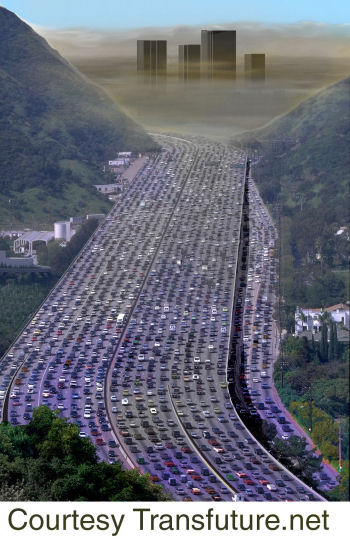
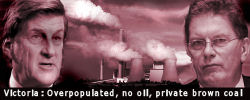 On the ABC News radio this morning (9 Sept 2012) we heard that private coal companies are demanding compensation for carbon trading costs from the Victorian Government and apparently this is being taken seriously!
On the ABC News radio this morning (9 Sept 2012) we heard that private coal companies are demanding compensation for carbon trading costs from the Victorian Government and apparently this is being taken seriously!

 WHO, UNSCEAR, IAEA, ICRP, governments and academia protect the nuclear industry by claiming that low-levels of ionizing radiation do not result in large numbers of health effects such as cancers and congenital abnormalities. It appears, however, that the ICRP risk factors underestimate health effects by a factor of 200 to 600. The Second Event Theory is one attempt to develop a mechanism that explains the dangers of low-level radiation. Meanwhile, in Japan recently, Mr. Hobun Ikeya, a veterinary surgeon and president of the Ecosystem Conservation Society-Japan caused an uproar by stating, “People in areas over which the radioactive plumes passed should not marry [...] If they give birth to children after getting married, the incidence of deformities may be very high.” He was referring to approximately 30 million people. He was asked by a number of Fukushima City councilors to retract the statement, but did not.
WHO, UNSCEAR, IAEA, ICRP, governments and academia protect the nuclear industry by claiming that low-levels of ionizing radiation do not result in large numbers of health effects such as cancers and congenital abnormalities. It appears, however, that the ICRP risk factors underestimate health effects by a factor of 200 to 600. The Second Event Theory is one attempt to develop a mechanism that explains the dangers of low-level radiation. Meanwhile, in Japan recently, Mr. Hobun Ikeya, a veterinary surgeon and president of the Ecosystem Conservation Society-Japan caused an uproar by stating, “People in areas over which the radioactive plumes passed should not marry [...] If they give birth to children after getting married, the incidence of deformities may be very high.” He was referring to approximately 30 million people. He was asked by a number of Fukushima City councilors to retract the statement, but did not. The Green Wedges Coalition explains how Planning Minister Matthew Guy wants to turn 6000ha of Melbourne's green wedges over to development. The Liberal Government has a majority of one in parliament and this green wedges destruction is a foregone conclusion if the Libs all vote to support Matthew. CDB Editor says: Ask your government representative what he or she intends to do to prevent this abrogation of democracy and this insult to our natural environment and the wildlife it shelters. Let us know their answer. If you read this after the voting, then ask your MP what he voted for. You can look it up on Hansard too. Addition: The “Logical Inclusions” (6000 ha excised from the green wedges, taking habitat wetlands etc.) was passed by Parliament on 14/8. The new threat to Green Wedges – may be even worse as it affects the non-growth councils like MPSC as well as the growth councils – is the proposed changes to the zones which would allow a lot of urban uses into the Green Wedges.
The Green Wedges Coalition explains how Planning Minister Matthew Guy wants to turn 6000ha of Melbourne's green wedges over to development. The Liberal Government has a majority of one in parliament and this green wedges destruction is a foregone conclusion if the Libs all vote to support Matthew. CDB Editor says: Ask your government representative what he or she intends to do to prevent this abrogation of democracy and this insult to our natural environment and the wildlife it shelters. Let us know their answer. If you read this after the voting, then ask your MP what he voted for. You can look it up on Hansard too. Addition: The “Logical Inclusions” (6000 ha excised from the green wedges, taking habitat wetlands etc.) was passed by Parliament on 14/8. The new threat to Green Wedges – may be even worse as it affects the non-growth councils like MPSC as well as the growth councils – is the proposed changes to the zones which would allow a lot of urban uses into the Green Wedges.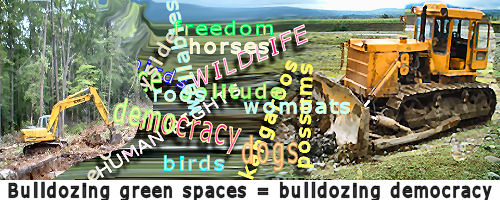

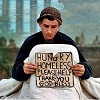 Jon Faine surprised many Victorians yesterday morning (4 September 2012) when he lambasted the abuse of 457 Visas in Victoria at a time of high local unemployment. He drew listeners' attention robustly to the folly of importing thousands of workers to industries where Australians could not even afford to train. Today, 5 September 2012, on ABC Radio 774, his guest was the Executive Director of the Australian Housing and Urban Research Institute (AHURI), but we heard not a word about how mass immigration is driving Australia's housing shortage nor how the property development growth lobby is driving mass immigration and the destruction of Victoria's green wedges and other greens spaces. Should we expect more of Jon Faine and the ABC or are ABC announcers constrained to toe the government line that supports the property development lobby?
Jon Faine surprised many Victorians yesterday morning (4 September 2012) when he lambasted the abuse of 457 Visas in Victoria at a time of high local unemployment. He drew listeners' attention robustly to the folly of importing thousands of workers to industries where Australians could not even afford to train. Today, 5 September 2012, on ABC Radio 774, his guest was the Executive Director of the Australian Housing and Urban Research Institute (AHURI), but we heard not a word about how mass immigration is driving Australia's housing shortage nor how the property development growth lobby is driving mass immigration and the destruction of Victoria's green wedges and other greens spaces. Should we expect more of Jon Faine and the ABC or are ABC announcers constrained to toe the government line that supports the property development lobby?

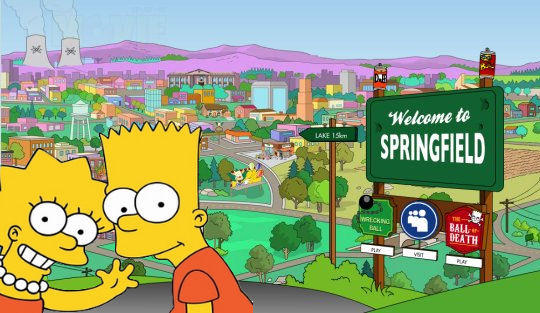


 "Any encroachment into our green spaces is irreversible. On the other hand, remaining faithful to the original intention of the green wedges, would give us all a more disciplined, sustainable, and welcoming city for the future." (Lady Hamer on 29 August 2012 as the Libs prepare to give bulldozers open slather on our green wedges, destroying wildlife and natural amenity.) Labor and the Liberals response is less than edifying and does not solve the problem. Basically both parties are in cahoots with the developers against the people of Melbourne.
"Any encroachment into our green spaces is irreversible. On the other hand, remaining faithful to the original intention of the green wedges, would give us all a more disciplined, sustainable, and welcoming city for the future." (Lady Hamer on 29 August 2012 as the Libs prepare to give bulldozers open slather on our green wedges, destroying wildlife and natural amenity.) Labor and the Liberals response is less than edifying and does not solve the problem. Basically both parties are in cahoots with the developers against the people of Melbourne.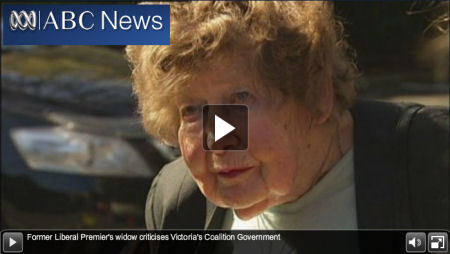

 Dingoes on Fraser Island, Australia are dying of starvation, with sand and grass in their stomachs. One woman tried to alert the world to this and was sentenced and fined for her trouble. On 25th of August 2012 Jennifer Parkhusrt received a national award from the
Dingoes on Fraser Island, Australia are dying of starvation, with sand and grass in their stomachs. One woman tried to alert the world to this and was sentenced and fined for her trouble. On 25th of August 2012 Jennifer Parkhusrt received a national award from the 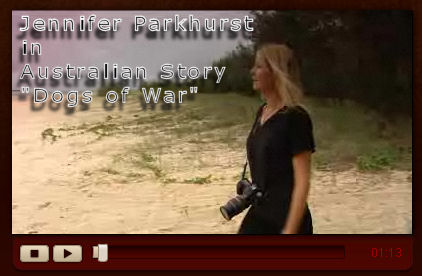

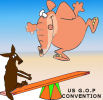 Tim Murray opines on free lunches, Canada as an international flophouse, the Republican manufacture and marketing of moral hallucinogens, and the notion of manifest destiny in the light of the laws of thermodynamics [you can't have your cake and eat it], as he listens to the US GOP (Republican) Convention.
Tim Murray opines on free lunches, Canada as an international flophouse, the Republican manufacture and marketing of moral hallucinogens, and the notion of manifest destiny in the light of the laws of thermodynamics [you can't have your cake and eat it], as he listens to the US GOP (Republican) Convention.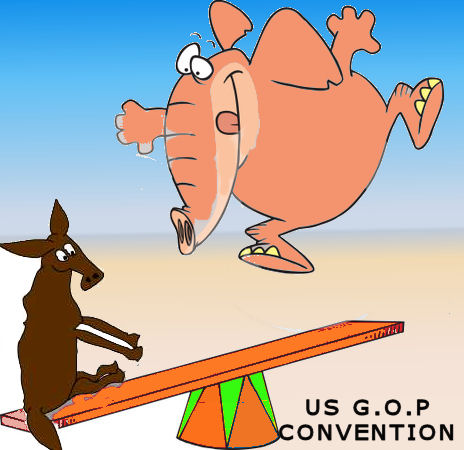

 Australia and Canada are in a race to the bottom to dig up all their minerals. They are importing workers and failing to train their own. Their politicians are caught up in the myth of sustainable economic growth. "The tar sands are the engine of that growth. And we'll want top dollar for what we export because the thirst for tax revenue is insatiable. We'll want the Americans to compete with the Chinese for the privilege of burning our bounty of black death. No wonder then that the support for continued mass immigration is bipartisan. We are in a big hurry to get that resource out of the ground and get it shipped out ASAP---so we bringing in migrant labour like mad to satisfy a "shortage" in skilled labour that we assume to exist because we have never conducted a proper inventory nor seriously tried to train our own people."
Australia and Canada are in a race to the bottom to dig up all their minerals. They are importing workers and failing to train their own. Their politicians are caught up in the myth of sustainable economic growth. "The tar sands are the engine of that growth. And we'll want top dollar for what we export because the thirst for tax revenue is insatiable. We'll want the Americans to compete with the Chinese for the privilege of burning our bounty of black death. No wonder then that the support for continued mass immigration is bipartisan. We are in a big hurry to get that resource out of the ground and get it shipped out ASAP---so we bringing in migrant labour like mad to satisfy a "shortage" in skilled labour that we assume to exist because we have never conducted a proper inventory nor seriously tried to train our own people."
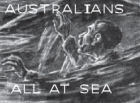 During the high immigration Howard era- the fuss about the boats was a smokescreen for the fact that we were getting a lot of extra government induced totally legal non- refugee immigration which was putting pressure on absolutely everything- environment, roads, housing etc. . Howard was a high population PM whist pretending to be jealously protecting Australia’s borders. This hypocrisy and the same game still goes on with Julia Gillard although without “children overboard”.
During the high immigration Howard era- the fuss about the boats was a smokescreen for the fact that we were getting a lot of extra government induced totally legal non- refugee immigration which was putting pressure on absolutely everything- environment, roads, housing etc. . Howard was a high population PM whist pretending to be jealously protecting Australia’s borders. This hypocrisy and the same game still goes on with Julia Gillard although without “children overboard”.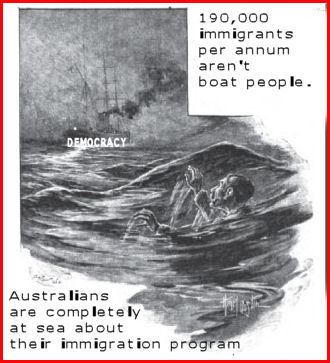



 The disingenuous who cannot refute your arguments often resort to sleight-of-hand alterations in terminology to make their case. Conflations are their stock in trade..... Lets not let our opponents get away with it.
The disingenuous who cannot refute your arguments often resort to sleight-of-hand alterations in terminology to make their case. Conflations are their stock in trade..... Lets not let our opponents get away with it. This delightful cartoon, by Marco Marilungo Pictor, depicts a conflated Pinocchio, apparently overwhelmed by his own complexity, under the somewhat calculating regard of his inventor, which so seemed to suit this topic that I purchased it from
This delightful cartoon, by Marco Marilungo Pictor, depicts a conflated Pinocchio, apparently overwhelmed by his own complexity, under the somewhat calculating regard of his inventor, which so seemed to suit this topic that I purchased it from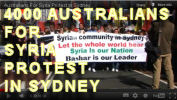 This is a fascinating video of a huge protest in Sydney on 5 August 2012 and we have put up a video of it with a number of interesting interviews from marchers, with comments from what they think of the Bashar Assad Government to how they don't like the Australian Greens policy on this matter and believe that we are risking World War Three by backing intervention in Syria. There is also some background on how Syria has been the long-term host one of the largest refugee populations in the world, which makes you wonder why it doesn't receive more support from Greens and Refugee activists. It must seem ironic that some candobetter.net EcoMalthusians are more inclined to give Syria that recognition! Please let us know if you have views on the democratic status of the Syrian government; we find it hard to judge. All comments and greetings welcome.
This is a fascinating video of a huge protest in Sydney on 5 August 2012 and we have put up a video of it with a number of interesting interviews from marchers, with comments from what they think of the Bashar Assad Government to how they don't like the Australian Greens policy on this matter and believe that we are risking World War Three by backing intervention in Syria. There is also some background on how Syria has been the long-term host one of the largest refugee populations in the world, which makes you wonder why it doesn't receive more support from Greens and Refugee activists. It must seem ironic that some candobetter.net EcoMalthusians are more inclined to give Syria that recognition! Please let us know if you have views on the democratic status of the Syrian government; we find it hard to judge. All comments and greetings welcome.

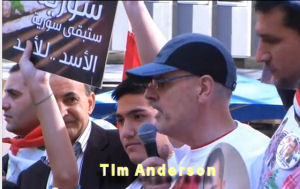


 Attention Avaaz, Amnesty International, NATO, Hilary...
Attention Avaaz, Amnesty International, NATO, Hilary...
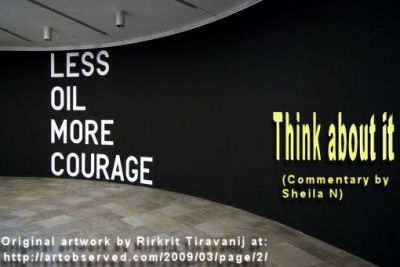 "What are they doing in Aleppo? Why are they doing? Why are they funded and helped and fueled with weapons and why are they introducing themselves in between the civilian population?"
"What are they doing in Aleppo? Why are they doing? Why are they funded and helped and fueled with weapons and why are they introducing themselves in between the civilian population?" It is great to see two politically engaged women speak out about Syria. On the one hand we have
It is great to see two politically engaged women speak out about Syria. On the one hand we have 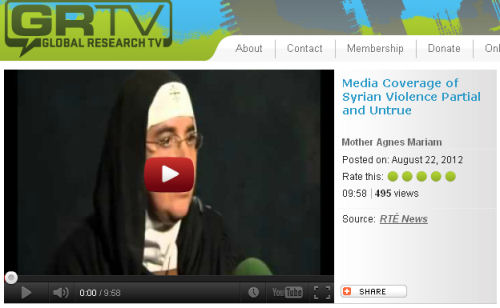
 Although First Nations are still dealing with the adverse effects of Colonization and Residential Schools, a new threat looms on the horizon. As Statistics Canada figures imply, immigration could likely be the next great obstacle that Canada's First People have to overcome in the fight to improve their lives.
Although First Nations are still dealing with the adverse effects of Colonization and Residential Schools, a new threat looms on the horizon. As Statistics Canada figures imply, immigration could likely be the next great obstacle that Canada's First People have to overcome in the fight to improve their lives.

 Dr Valerie Yule describes how our economic system removes our ability to choose what we really want and need.
Dr Valerie Yule describes how our economic system removes our ability to choose what we really want and need.

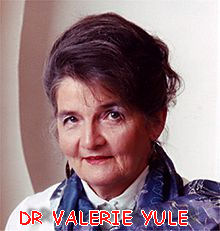

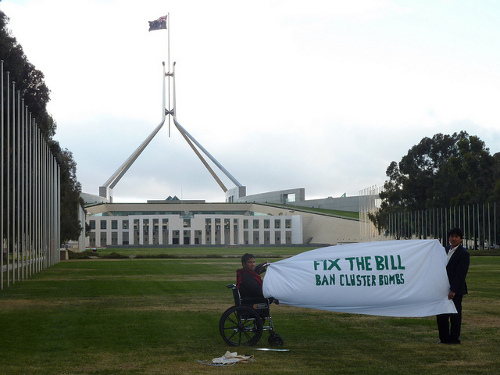

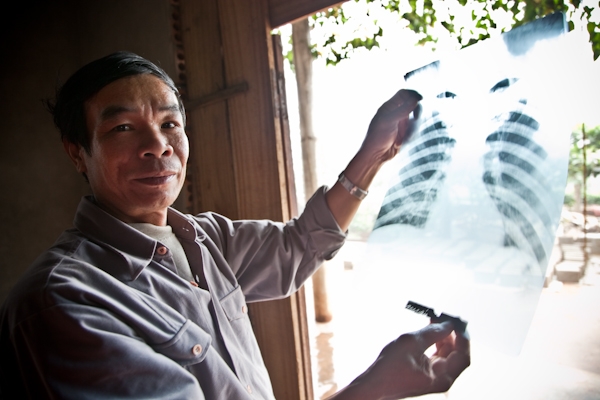
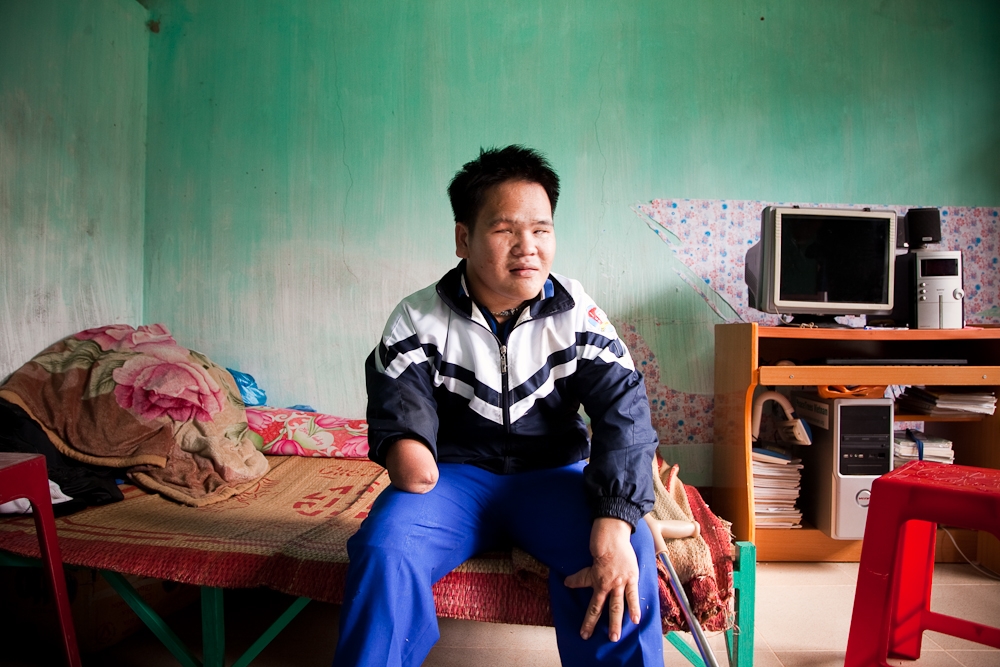
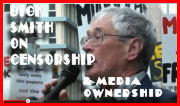
 Dick Smith says he has been refused advertising space about his new magazine, Forbidden Ideas, by the Murdoch Press in Adelaide. Here is a film where he speaks his mind on what he perceives to be censorship. This is really a quite funny and very informative speech by an animated Dick Smith.
Dick Smith says he has been refused advertising space about his new magazine, Forbidden Ideas, by the Murdoch Press in Adelaide. Here is a film where he speaks his mind on what he perceives to be censorship. This is really a quite funny and very informative speech by an animated Dick Smith.

 Despite the fact there are no publicly available plans for this project, Stage One of construction of the East West Link has already commenced with "geological investigation" (i.e. drilling for soil and rock samples and testing for underground water) along the proposed alignment of the above/under/on ground road way. As spelt out in the Eddington Review of 2008 the freeway/tollway is likely to be open cut through Royal Park. It seems that there has been a total failure to responsibly and democratically consult the Victorian Public on their wishes in this matter as it affects public lands. The snap protest will be held near the reserve with the drilling rig at the corner of Neill and Canning Streets Carlton outside the Dan O’Connell Hotel starting at 12:30 pm. (Melways Map Reference 2BK4).
Despite the fact there are no publicly available plans for this project, Stage One of construction of the East West Link has already commenced with "geological investigation" (i.e. drilling for soil and rock samples and testing for underground water) along the proposed alignment of the above/under/on ground road way. As spelt out in the Eddington Review of 2008 the freeway/tollway is likely to be open cut through Royal Park. It seems that there has been a total failure to responsibly and democratically consult the Victorian Public on their wishes in this matter as it affects public lands. The snap protest will be held near the reserve with the drilling rig at the corner of Neill and Canning Streets Carlton outside the Dan O’Connell Hotel starting at 12:30 pm. (Melways Map Reference 2BK4). 
 A political analyst says the West is hypocritically recruiting the same thugs it supposedly waged the bloody and costly ‘war on terror’ against a decade ago, to topple the Syrian government today.
A political analyst says the West is hypocritically recruiting the same thugs it supposedly waged the bloody and costly ‘war on terror’ against a decade ago, to topple the Syrian government today.
 75% of Victorians think that shooting of native water birds should be banned. 91% of people living in Melbourne don't want shooting and 77% in the country agree. The
75% of Victorians think that shooting of native water birds should be banned. 91% of people living in Melbourne don't want shooting and 77% in the country agree. The 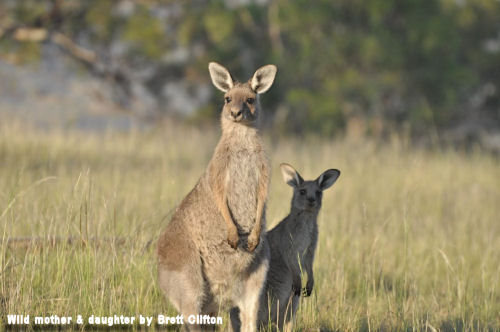
 If anyone needs additional proof of the tremendous censorial control wielded over corporate and alleged "independent" media regarding Western powers' imperialist projects they need look no further than the thorough news blackout of the August 9 Tehran Consultative Conference on Syria.[1] As this censorship ensued, "progressive" news outlets continued their barrage of dubious and misleading information on the continuing turmoil within Syria.
If anyone needs additional proof of the tremendous censorial control wielded over corporate and alleged "independent" media regarding Western powers' imperialist projects they need look no further than the thorough news blackout of the August 9 Tehran Consultative Conference on Syria.[1] As this censorship ensued, "progressive" news outlets continued their barrage of dubious and misleading information on the continuing turmoil within Syria.
 This article commentates the parliamentary 'debate' on 14 August 2012 on this bill, including how these politicians avoid confronting the driver of overpopulation. We also cite speakers on the associated ills: "[T]he government is setting us up for privatisation of the permit system. That is the holy grail. [...]What we have here in Victoria is the product of a mad scientist experiment, turning a simple matter — something that is simple in cities around the world, planning and building codes — into a privatised, almost anything goes objective-based system that is fundamentally broken. We think this approach is fundamentally wrong. There is a simple and easy process for the minister to achieve the same objective within the existing provisions of the Planning and Environment Act 1987." (Greg Barber, Greens)
This article commentates the parliamentary 'debate' on 14 August 2012 on this bill, including how these politicians avoid confronting the driver of overpopulation. We also cite speakers on the associated ills: "[T]he government is setting us up for privatisation of the permit system. That is the holy grail. [...]What we have here in Victoria is the product of a mad scientist experiment, turning a simple matter — something that is simple in cities around the world, planning and building codes — into a privatised, almost anything goes objective-based system that is fundamentally broken. We think this approach is fundamentally wrong. There is a simple and easy process for the minister to achieve the same objective within the existing provisions of the Planning and Environment Act 1987." (Greg Barber, Greens)


 Bill McKibben has recently unveiled some new "terrifying math" about global warming. But there are other numbers that terrify me more. My mother used to tell me to stop worrying, because it is not the things we worry about that usually get us, but the things we don't see coming. I think she was right.
Bill McKibben has recently unveiled some new "terrifying math" about global warming. But there are other numbers that terrify me more. My mother used to tell me to stop worrying, because it is not the things we worry about that usually get us, but the things we don't see coming. I think she was right.  Bill McKibben recently wrote about the “terrifying math” of global warming:
Bill McKibben recently wrote about the “terrifying math” of global warming:
Recent comments